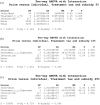Do tax and subsidy on unhealthy food induce consumer consumption for healthy food? Evidence from experiment in Surabaya, Indonesia
- PMID: 36686586
- PMCID: PMC9850130
- DOI: 10.1177/22799036221147362
Do tax and subsidy on unhealthy food induce consumer consumption for healthy food? Evidence from experiment in Surabaya, Indonesia
Abstract
Background: This study investigates the impact of price changes on decision to buy particular foods among adults in Surabaya, East Java, Indonesia. Tax and subsidy were introduced for influencing decision buy particular foods, especially unhealthy foods that are predicted have consequences on health outcome. Unhealthy foods such as fast foods or junk foods, sugar sweetened beverages (SSB), salty, and fatty foods are reported as one of main causes of obesity incidence in most countries, such as Indonesia.
Design and method: Computer laboratory experimental is designed for investigating the impacts of difference rates of taxes and subsidy on decision to buy foods. Taxes and subsidies rate are designed from low (5%), moderate (15%), and high rates (25%).
Results: The findings are as follows. Firstly, participants do not respond immediately to price changes, that is, higher prices due to taxes and lower prices due to subsidies. Economic theory suggests that consumers demand for basic need such as foods is sensitive with change in price, they respond inversely to the price changes. However, the finding in this experimental study do not support this theory prediction. Secondly, 15% and subsidies are the threshold and the larger taxes and rate for changing consumer's choices on targeted foods.
Conclusion: This study concludes that low rates of taxes and subsidies for unhealthy and healthy foods make these targeted foods affordable for majority of consumers. Besides introducing higher rates of taxes and subsidies, promoting and encouraging healthy life style such as consuming fresh and healthy foods is another alternative policy option.
Keywords: health promotion; healthy and unhealthy foods; taxes and subsidies.
© The Author(s) 2023.
Conflict of interest statement
The author(s) declared no potential conflicts of interest with respect to the research, authorship, and/or publication of this article.
Figures



Similar articles
-
Taxes and Subsidies for Improving Diet and Population Health in Australia: A Cost-Effectiveness Modelling Study.PLoS Med. 2017 Feb 14;14(2):e1002232. doi: 10.1371/journal.pmed.1002232. eCollection 2017 Feb. PLoS Med. 2017. PMID: 28196089 Free PMC article.
-
Taxation of sugar sweetened beverages and unhealthy foods: a qualitative study of key opinion leaders' views.Isr J Health Policy Res. 2018 Jul 31;7(1):43. doi: 10.1186/s13584-018-0240-1. Isr J Health Policy Res. 2018. PMID: 30064503 Free PMC article.
-
Study protocol: combining experimental methods, econometrics and simulation modelling to determine price elasticities for studying food taxes and subsidies (The Price ExaM Study).BMC Public Health. 2016 Jul 19;16:601. doi: 10.1186/s12889-016-3277-5. BMC Public Health. 2016. PMID: 27435175 Free PMC article.
-
The Effects of Subsidies for Healthy Foods on Food Purchasing Behaviors, Consumption Patterns, and Obesity/Overweight: A Systematic Review.Nutr Rev. 2025 Jul 1;83(7):e1722-e1739. doi: 10.1093/nutrit/nuae153. Nutr Rev. 2025. PMID: 39468774
-
Do taxes on unhealthy foods and beverages influence food purchases?Curr Nutr Rep. 2021 Sep;10(3):179-187. doi: 10.1007/s13668-021-00358-0. Epub 2021 Apr 30. Curr Nutr Rep. 2021. PMID: 33929703 Review.
Cited by
-
Cost-effectiveness of tax policies on promoting sustainable diets in Iran: a modeling study.Front Nutr. 2024 Oct 21;11:1453969. doi: 10.3389/fnut.2024.1453969. eCollection 2024. Front Nutr. 2024. PMID: 39498406 Free PMC article.
References
-
- Ministry of Health, Indonesia KKR. Paparan Hasil Riset Kesehatan dasar Tahun 2018. Ministry of Health, 2018.
-
- LPM_Sinovia. Pandemi Belum Berakhir, obesitas meningkat. Apa yang Terjadi? https://med.unhas.ac.id/sinovia/2021/06/29/pandemi-belum-berakhir-obesit... (2021, accessed 28 March 2022).
-
- Buchmueller TC, Johar M. Obesity and health expenditures: evidence from Australia. Econ Hum Biol 2015; 17: 42–58. - PubMed
LinkOut - more resources
Full Text Sources
